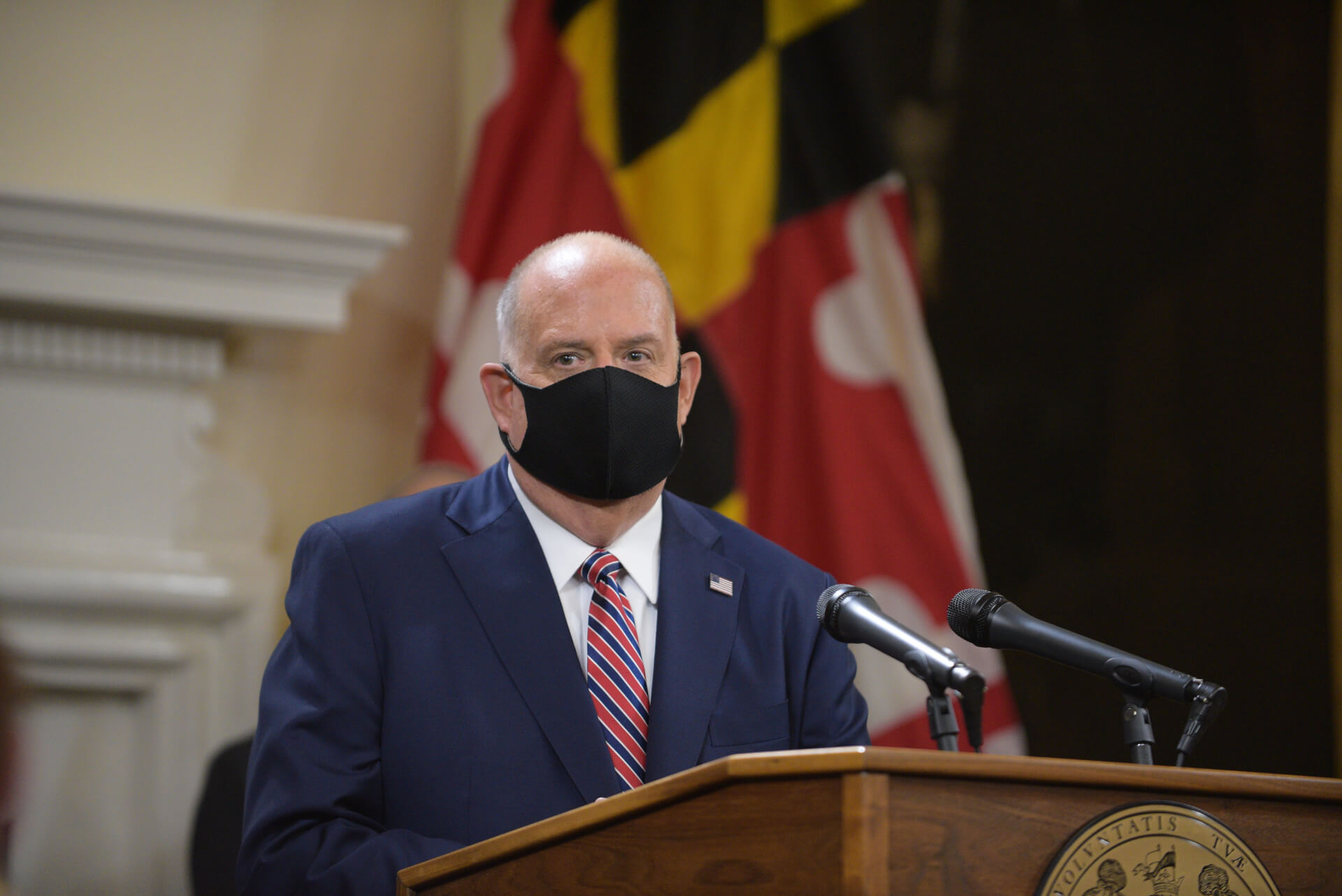As COVID Cases Rise Into ‘Danger Zone,’ Hogan Tightens Restrictions

As the number of Marylanders with COVID-19 continues to rise and the state crossed warning thresholds set by the Centers for Disease Control and World Health Organization, Gov. Lawrence J. Hogan Jr. (R) reduced dine-in capacity for bars and restaurants, issued new guidance to avoid out-of-state travel, encouraged telework and asserted that a coronavirus surge could be in Maryland’s future.
Maryland has had seven straight days with more than 1,000 new cases. The state has crossed over into a “danger zone,” Hogan said.
“Too many residents and businesses have COVID fatigue, and they began letting their guard down. Too many Marylanders are traveling out of state to unsafe locations, hosting large gatherings, crowding in bars, attending house parties, and refusing to wear masks. Too many businesses are failing to comply with the state regulations and orders. And counties with the primary responsibility for ensuring compliance of the law and enforcing public health regulations are in some cases failing to do so,” Hogan said during a State House news conference Tuesday evening. “Sadly, as a result, the virus has returned to our state in a big way.”
On Monday, for the first time since June 25, Maryland’s 7-day statewide positive COVID-19 test rate crossed over a 5% benchmark ― one of several metrics that can be used to monitor the spread of COVID ― set by the CDC and WHO.
Ten Maryland counties and the city of Baltimore had positive test rates above that benchmark on Tuesday. The counties are: Allegany, Anne Arundel, Baltimore, Charles, Dorchester, Garrett, Harford, Queen Anne’s, Somerset and Washington.
Several jurisdictions are also in the federal government’s “red zone” for COVID-19 case rates. There are more than 20 cases per 100,000 residents in seven jurisdictions: the city of Baltimore and Allegany, Washington, Baltimore, Harford, Anne Arundel and Somerset counties.
On Tuesday morning, the state reported 1,338 new COVID-19 cases. At least 761 Marylanders ― an increase of 54 people since Monday ― were hospitalized, including 176 patients in intensive care. Nationwide, coronavirus hospitalizations surged to a record high on Monday with more than 59,000 patients.
The state reported 12 deaths on Tuesday morning. At least 4,084 Marylanders have died from the virus since March.
Through executive order and directives, the Hogan administration on Tuesday re-imposed or reinforced public health restrictions in an effort to curtail an ongoing surge in COVID-19 cases:
- Effective Wednesday at 5 p.m., the capacity for indoor operations at bars and restaurants will be reduced to 50%, with service only for customers who are seated and socially distanced, plus other precautions.
- The health department issued a new public health advisory strongly warning against any indoor gatherings of 25 people or more.
- The health department expanded an advisory against all out-of-state travel. Marylanders are strongly advised to avoid all nonessential travel to any state with a positivity rate above 10% or an average case rate of 20 cases per 100,000 residents. Thirty five states have a case rate over 20, and eight states have a positivity rate over 10%.
- Effective immediately, all state employees who are approved to telework must once do so. Private employers are encouraged to increase telework and do everything possible to increase distancing among employees who must be physically present.
- The state health department is also activating the next level of planning to increase hospital surge capacity by adding space in temporary hospital facilities and providing additional staffing support to nursing homes.
- New guidance from the health department says that all visitors to nursing homes should be tested for the virus, that gatherings should be avoided and that nursing homes should create stockpiles of protective equipment.
Hogan said contact tracing data continues to show that gatherings of family and friends are the most common source of viral spread, with increasing numbers of newly infected Marylanders indicating they recently ate in a restaurant or work outside of the home.
Hogan did not move back from “Phase 3” in the state’s recovery plan, which allows all businesses to be open with some restrictions. For now, the additional steps and stronger enforcement of existing precautions reflect the state’s infection and contact tracing data, but more restrictions could become necessary if cases continue to rise, Hogan said.
“We do not want to take actions that will further burden our struggling small businesses, or actions to shut down our economy,” Hogan said. “Our primary goals continue to be keeping our hospitals from overflowing and stopping more Marylanders from dying.”
Counties are able to move more slowly in the reopening plan, based on local conditions, and some have.
Over the weekend, the leaders from Maryland’s six largest jurisdictions sent Hogan a letter urging a statewide tightening of restrictions.
“Our residents do not live their lives confined within the borders of our counties – so our efforts to contain this deadly virus should not either,” the leaders wrote. “We want to partner with you in the effort to crush the curve and beat this virus.”
But, the leaders wrote that as recently as Oct. 22, Hogan criticized them for not moving forward with lifting Phase 3 restrictions and that he had not participated in a statewide conference call with county leaders in 169 days.
At the press conference, Hogan said the same county leaders had not raised their concerns during meetings held every-other-week with his state leadership team. And Hogan noted that some of those leaders, all Democrats, have higher political ambitions.
Hogan also said that it is the counties that need to do more to help curb the spread, including by more strictly enforcing capacity limits at bars and restaurants.
Some jurisdictions have recently implemented stronger precautions, including Montgomery and Allegany counties and the city of Baltimore.
Cases in the rural Allegany County are escalating at a rate that is nearly three times the state average. A state testing site will begin operating in the county on Wednesday.
The Allegany County Board of County Commissioners announced that they would impose additional restrictions, including reducing capacity of bars, restaurants, fitness and recreation centers and other retail businesses to 50 percent. The county office building will be accessible by appointment only.
In Baltimore City, Mayor Bernard C. “Jack” Young moved the city back into Phase 1, the most restrictive phase of economic closures after case rates and positive test rates in the city more than doubled in the past two weeks.
Statewide, there have been two peaks in COVID cases so far ― on April 30, when there were 1,711 hospitalizations, and on Aug. 1, when there were 592 hospitalizations.
A third rise began in mid-October.
Baltimore County Executive John A. Olszewski Jr. (D) issued a statement in response to Hogan’s press conference saying that “statewide solutions remain the most effective public health actions” and that the county will follow metrics to determine if any additional actions are needed.
Maryland Senate President Bill Ferguson (D-Baltimore City) tweeted that he strongly supported the plan to reimpose public health measures to stop the spread.
“Virus increasing too quickly. All of us must take action to keep all of us safe,” Ferguson tweeted. “Our regular reminder ― public health = economic health.”
During the Tuesday press conference, Hogan also confirmed that Maryland Department of Health Secretary Robert R. Neall will retire from state government, effective Dec. 1.
Hogan described Neall as “a long-time friend for decades and who’s done an incredible job leading a wonderful team of people throughout this crisis.”
The retirement was announced at an emergency cabinet meeting Tuesday. Hogan said he could offer no further details Tuesday evening.
Fran Phillips, the state’s longtime public health chief, retired during the summer.




 Creative Commons Attribution
Creative Commons Attribution